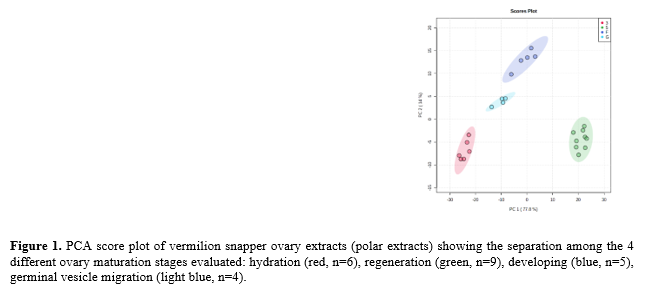INITIAL ASSESSMENT OF NUCLEAR MAGNETIC RESONANCE-BASED METABOLOMICS AS A TOOL FOR THE IDENTIFICATION OF SKIP-SPAWNING BIOMARKERS
Estimating reproductive potential is an integral but challenging task in fish stock assessments. Evidence suggests that several species may skip spawning in response to changes in nutritional, environmental, or anthropogenic conditions, which may have serious effects on the assessment. Accurate estimates of skipped spawning within a population is, therefore, a critical component to fishery recruitment assessments. Previous methods for the estimation of skipped spawning include macroscopic assessments of different reproductive phases and monitoring migration to spawning grounds. The degrees of skipped spawning typically associated with these methodologies are extremely variable, resulting in somewhat inaccurate estimates of the relative proportions of skipped spawners and therefore recruitment. We are currently working on the development of a novel analytical approach to quantify the reproductive potential of fish populations.
Nuclear Magnetic Resonance (NMR)-based metabolomics is a high-resolution analytical technology that can detect changes in metabolic profiles induced by a variety of factors including disease, xenobiotic toxicity, and nutritional status. The physiological and hormonal changes occurring during spawning within the gonad can significantly alter the tissue metabolic profiles. NMR-based metabolomics has the capability of identifying specific metabolic "fingerprints" as well as identifying and quantifying potential biomarkers which will clearly differentiate skip spawning females from spawning individuals. We intend to apply this technique to address additional questions in broodstock management and selection.
In a preliminary study, we have analyzed 24 ovarian tissue extracts at 4 different maturation stages from a species of interest in the U.S. South Atlantic: Vermilion Snapper (Rhomboplites aurorubens). Polar extracts were analyzed using NMR-based metabolomics. Principal Component Analysis (PCA) was performed on the processed NMR spectra and the resulting PCA scores plot is shown (Fig. 1). Our results show that the metabolite profiles of all 4 ovarian maturation stages evaluated in this study were significantly different from each other, thus demonstrating that NMR metabolomics has the potential to clearly discriminate between ovaries at different maturation stages.
